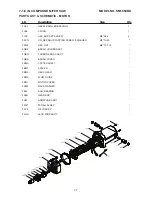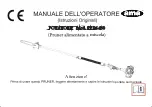
26
WORKPIECE SUPPORT (FIGURE FF)
Long pieces need extra support. The
support should be placed under the
workpiece. Keep your hand holding the
workpiece positioned 6 in. or more away
from the blade. The support must let the
workpiece lay flat on the work table during
the cutting operation.
NOTE:
When mounted on a flat surface,
the saw table is 2-2/3 inches high.
AUXILIARY WOOD FENCE
(FIGURE GG)
When making multiple or repetitive cuts
that result in cut-off pieces of one inch
or less, it is possible for the saw blade to
catch the cut-off piece and throw it out
of the saw or into the blade guard and
housing, possibly causing damage or
injury. To minimize this an auxiliary wood
fence can be mounted to your saw. Holes
are provided in the saw fence to attach an
auxiliary wood fence (this provides
additional depth of cut). This fence should
be constructed of straight auxiliary wood
approximately 3/4 in. thick by 1-1/2 in.
high by 16 in. long. Attach the wood fence
securely and make a full depth cut to
make a blade slot. Check for interference
between the wood fence and the lower
blade guard. Adjust if necessary.
Blade slot
Auxiliary
fence
FF
GG
2-2/3
in.
CUTTING BASE MOLDING
(FIGURE HH)
Base moldings and many other moldings
can be cut on a compound miter saw.
The setup of the saw depends on molding
characteristics and application, as shown.
Perform practice cuts on scrap material to
achieve best results:
•
Always make sure moldings rest firmly
against fence and table. Use hold-
down, crown molding vise or C-clamps,
whenever possible, and place tape on
the area being clamped to avoid marks.
• Reduce splintering by taping the cut
area prior to making the cut. Mark the
cut line directly on the tape.
• Splintering typically happens due to an
incorrect blade application and thinness
of the material.
NOTE: Always perform a dry run cut so
you can determine if the operation being
attempted is possible before power is
applied to the saw.
CUTTING CROWN MOLDING
(FIGURE II, JJ)
Your compound miter saw is suited for
the difficult task of cutting crown molding.
To fit properly, crown molding must be
compound-mitered with extreme accuracy.
The two surfaces on a piece of crown
molding that fit flat against the ceiling
and wall are at angles that, when added
together, equal exactly 90°.
Most crown molding has a top rear angle
(the section that fits flat against the
ceiling) of 52° and a bottom rear angle (the
section that fits flat against
the wall) of 38°. In order to accurately cut
crown molding for a 90° inside or
HH
Workpiece
F
e
n
c
e
Miter saw table
miter at 45°, bevel at 0° miter at 0°, bevel at 45°
F
e
n
c
e
Miter saw table
Workpiece













































